In the footsteps of 500 Years of Reformation
October 31st, 2017 will mark the 500th Anniversary of the world changing event when religious reformer Martin Luther nailed his arguments against the practices of the Catholic Church, his “95 Theses” to a church door in Wittenberg, Germany beginning the Protestant Reformation.
I recently took a trip to follow in the footsteps of the monk turned protestant icon, and wondered how to frame it. It’s a complex story, but how to begin? And like a sentence in German where you don’t know the meaning until you get to the verb at the end, I didn’t know how to shape it until the last day of my journey when two stark threads came to together.
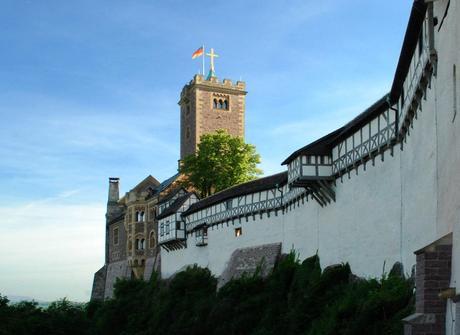
Wartburg Castle
For the traveler, following the trail of the famous reformer can be a fascinating way to explore a beautiful country, but also a journey through history and culture. Luther spent much of his life in what is for the most part in the former East Germany, which provides its own paradoxes. And just as changes in religious outlook can lead to myriad consequences, a journey in these footsteps, beginning with one monk’s complaints about what he saw as the perversion of his religion to unintended ends, following a trail of this road wanderer leads to many surprises.
To make the experience more international, I was with a group from across the globe, from China, Japan, Sweden and Poland, and two of us from the US, an eclectic bunch, some with knowledge of the subject and some with just a curiosity.
I’ve been to Germany often, but this was my first trip on the giant bus of the air, a double decker Lufthansa Airbus 380. It’s like riding on a football field of chairs, with another floor above your head. With over five hundred passengers, it’s a crowd, but the entertainment system offers lots of options (including a tail camera so you don’t have to look out a window), and the liquor is free! At least at the Frankfurt Airport, the rail station is just an escalator ride down from the baggage claim, to get on one of Germany’s now ubiquitous ICE High Speed trains to our first stop on the Luther Trail.
Eisenach and Wartburg Castle
Wartburg Castle (pronounced Vartbourg) is one of the most visited Luther sites. It was here, while holed up in a small wood-lined chamber, Martin Luther began his translation of the First Testament of the Bible into common German. The legend has it, after escaping from judgment under excommunication and refusing to recant his views before the Council at Worms, hurrying back to his home, he was kidnapped on the road by a band of men, who turned out to be friends in the service of the Prince Elector Frederick III (Frederick the Wise). He was spirited away to the castle high on a hill above the town of Eisenach. Here he grew his monk’s tonsure into long hair and a beard. He called himself the “Knight George”, taking the name from St George and his dragon, and for ten months he worked on his Bible, arguing with the devil and throwing his inkwell to chase him from his small room.

Luther Room at Castle Wartburg
Through November 5, 2017 one of three National Exhibitions commemorating the anniversary of beginning of the Reformation is being presented at Wartburg, transforming the magnificent Romanesque Revival rooms of the castle into an exploration of “Martin Luther and the Germans”, focused on the question of how the eras of German history have formed their own unique views of Luther.
With three hundred individual exhibits from the Wartburg Foundation collection or on loan from other institutions, including interactive media stations, highlights of the exhibition include 16th century paintings and graphic works from the period of Luther’s life by Lucas Cranach the Elder, Lucas Cranach the Younger, and Albrecht Dürer, as well as more modern interpretations from the 19th and 20th centuries. Historical objects include an original double eagle banner from the Holy Roman Empire from 1532, and a replica of the golden bejeweled crown of the Holy Roman Emperor, Charles the Great.
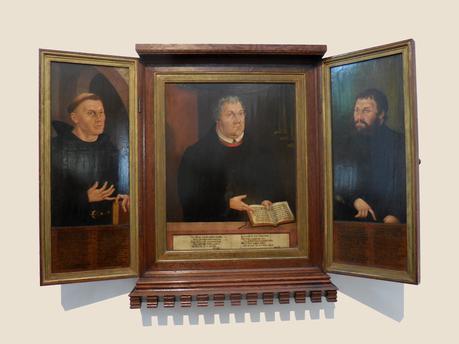
Panels of Martin Luther
Aside from Wartburg Castle, in the town of Eisenach is the house where Martin Luther lived as a boy for three years while attending Latin school, the Luther House Eisenach. The museum houses the original Luther Rooms from the 16th Century, a permanent exhibit on “Luther and the Bible” and a special anniversary exhibition on “The Catholic View of Luther – Heretic, Schismatic, Teacher of the Faith”.
What Else to Do in Eisenach
Eisenach also has a music history as the town where composer Johann Sebastian Bach was born. It has the first museum in Germany dedicated to the composer, in a house his family owned, though there is some dispute whether he was actually born there. The fount where Bach was baptized is in St George’s church. And the Reuter Wagner Museum holds the second largest Richard Wagner Collection in the world. Wagner was so inspired by Wartburg Castle he made it the setting for his opera, Tannhäuser.
Where to stay: the Steigenberger Eisenach Thuringer Hof is located directly on the town square across from the statue of Martin Luther, a ten minute walk from the train station.
Where to dine: the Weinrestaurant Turmschänke Karlsplatz 28 is in the historic tower of the remaining medieval city wall gate, across from the statue.
Schmalkalden
Not far from Eisenach is the village of Schmalkalden, with one of the best preserved medieval town centers in Germany. It was here in 1531 that Martin Luther met with the leading families and ruling houses of Northern Germany, by then inclined to follow Luther’s new version of the faith. The nobles of the north had been yearning to form their own alliance separate from the Catholic Holy Roman Empire in the south controlled by the Habsburgs. Protestantism would form the dividing line. The Schmalkaldic League was named after the town where they met. Arrayed around the town square on the remaining buildings are displayed the heraldic shield signs of the many noble houses who gathered to meet.
The League lasted until about 1552, after losing a war, but gaining a political victory, thanks to the building threat from the encroaching Muslim Turks of Suleiman the Magnificent, when Emperor Charles V’s signing of the Augsburg Peace allowed the prince rulers to choose which religion would be practiced in their own lands, giving us the permanent Reformation.
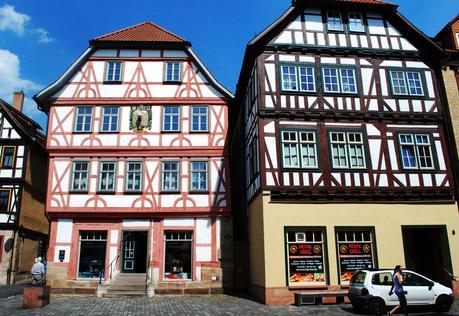
Luther House Schmalkalden
The Wilhelmsburg Castle in Schmalkalden has installed an exhibition “Dawn of an Era” with interactive stations, art and artifacts telling the story of Luther and the Schmalkaldic League. The exhibition is in German only, but a guided tour can be arranged.
In the town, half-way between the central square and the castle is the house where Luther stayed while in Schmalkalden. It is not currently a museum, but an apartment building. On the first floor is a book shop with Luther related items, while upstairs, the rooms where Martin Luther stayed in ill health while passing a kidney stone, demanding the league potentates come to him so he could present his Articles of Faith, are being renovated.
St. George’s Church also has a room where Luther stayed, once again in hiding, upstairs above the precept, with a small window looking out to the choir below, with its original baptismal font from the 16th Century.
Where to dine: The Ratskeller Schmalkalden at Altmarkt 2, on the ground floor of the town hall is a traditional German restaurant directly on the main square. Or try an ice cream from one of the street facing bakeries on the square while counting the heraldic shields and contemplating the difference between the Hanseatic League and the house of Saxony.
Before continuing our tour, a bit about food in Germany
Martin Luther, from so many paintings by his friend and promoter, Lucas Cranach the Elder, was notoriously rotund in later life and dining on traditional German food will give you an idea why. The Thuringian diet, much like Bavaria, is heavy on meat. Thuringia Sausages are a particular delight, and any traditional Brauhaus will provide pork from almost any corner of the animal, in large knuckle parts to a back steak (a pork chop).
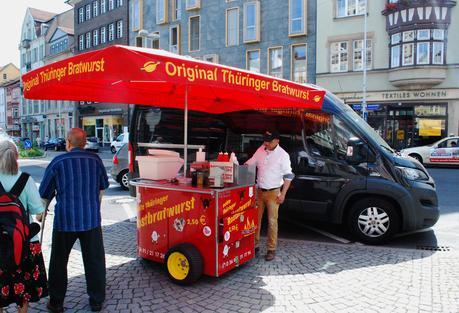
Streetside Thuringer Sausage
The Thuringia dumpling is tasty but in texture rather like a gelatinous croquet ball, meant to sustain farmers working long days in the field. At one stop in Augsburg, a rather new trend seemed on offer, taking the concept of the Tapas Bar and applying it to a German menu, allowing a mix of sample portions from appetizers to main course and dessert.
In the north, I discovered a rather unique take on the familiar burger with a crusty potato cake for a bun, though eating it with a knife and fork seemed more sensible that trying to lift it with the hands. Fresh fish and vegetarian items are available for the less meat inclined, but interpreting a German menu might take some assistance. This central part of Germany is rich in farmland and the local markets held in any town square can be filled with colorful riches of local fruits and veggies.
Coburg
From Schmalkalden we travel south by almost two hours to Coburg. In Luther’s time it would be about three days by horse at 30 miles a day. Coburg in Franconian Bavaria is the traditional family capital of the Saxe-Coburg’s who married into the English royal family when the young Queen Victoria wedded Prince Albert. The royal family changed their name to the Windsors during the anti-German sentiment of World War I.
Coburg also had a bit of luck in 1920 after the breakup of the former German Empire and the formation of the Weimar Republic. The people were given a chance to choose whether they wanted to remain a part of Thuringia or join with Bavaria. They voted around 90 percent to switch to Bavaria, with the luck being after WWII, they were in West Germany, while Thuringia was in the socialist sector.
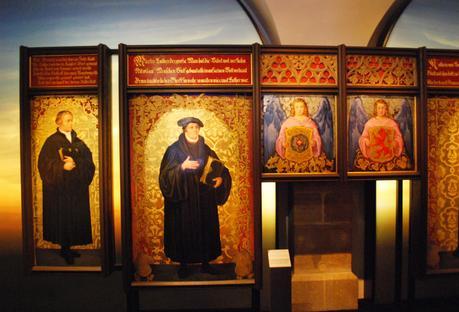
Luther Panels at Veste Coburg
Martin Luther’s connection to Coburg is the six months, from April to October of 1530, he stayed in the great castle fortress, the Veste Coburg (Veste sometimes Fest meaning holdfast or stronghold) during the Imperial Diet of Augsburg. Coburg was then in Thuringia, controlled by the John of Saxony, called John the Steadfast, who had succeeded Frederick the Wise on his death in 1525. John was the leader of the Schmalkaldic League and would go to the Imperial Council, but fearing the Luther was subject to arrest and burning for heresy if he entered Bavaria, ordered him to wait in Coburg. His friend, Phillip Melanchthon, would present his doctrine to the council in the Confession of Augsburg. While awaiting the outcome from Augsburg, Luther would continue his translation of the Bible in his rather more comfortable rooms in the fortress castle.
The Veste Coburg is presenting a special anniversary exhibit “Ritter, Bauern, Lutheraner” (Knight, Peasant, Lutheran)” through November 5, 2017. The exhibit offers a fascinating collection of artifacts winding through the great halls of the castle.
What Else to Do In Coburg
As the ruling seat of the house of Saxe-Coburg, the city has a number of sites related to Prince Albert. The home where he was born, Schloss Rosenau with its setting Queen Victoria called “the queen’s view” over a hedge of roses, and the romantic 19th Century Castle of Callenberg, still owned by the family.
Where to stay: Hotel Goldener Anker Rosengasse 4 is convenient to the old town, just inside the remaining gate of the medieval city walls.
Where to dine: Brauhaus Zu Coburg Nägleinsgasse 4 a traditional brewery restaurant just off the main town square where the statue of Prince Albert watches over the old city market.
Augsburg
From Coburg it’s on to Augsburg, not far from Munich and called the gateway to the Alps, at least for those traveling the Romantic Road to the south and the largest city on the Luther Trail.
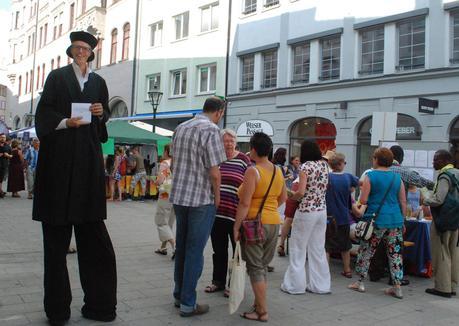
Martin Luther on Stilts at Augsburg Market
The Protestant reformer has two associations with the city. In his early days, after nailing his 95 Theses to the church doors in Wittenberg, he is called to answer at the Imperial Council of 1518. He is interrogated by Cardinal Thomas Cajetan and asked to recant with just a simple 6 letter word in Latin “Revoco”, but refuses. He stays for five days in rooms at the Cloister Church of St Anne while he presents his arguments. Realizing he could be arrested after three days of debate, he escapes.
Then again in 1530, after his Lutheran view has begun to take hold, he offers his Confession of Augsburg (Augustan Confession) with the 28 basic articles of the new faith, but doesn’t come to the city himself. The Church of St. Anne has a permanent exhibit called the Lutherstieg (Luther Stairs) encompassing the rooms where Luther hung out, with an interactive dialog with Cardinal Cajetan.
What Else to Do in Augsburg
Augsburg is a vibrant city. It is the city where Mozart’s father Leopold was born and taught music at the still existing Mozart House Museum. Named for the Roman Emperor Caesar Augustus, the town stood at the end of the road from Rome. Augustus never visited the town himself but it was named for him by a nephew, and his statue stands imperially in the town square.
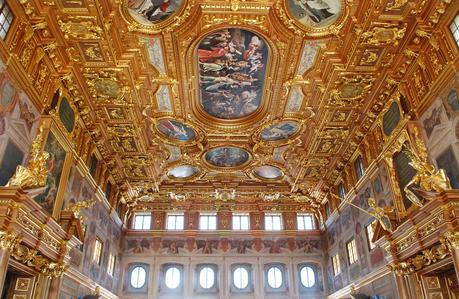
Golden Hall Augsburg Town Hall
The town’s growth in the middle ages is much due to two wealthy mining and shipping families, the Fuggers and Welsers. Jakob Fugger built a residential neighborhood for the poor, still standing, the Fuggerei, and their story is told in a new museum with talking interactive video screens, the Fugger and Welser Erlebnis Museum. The Golden Hall (Goldener Saale) in the city’s Town Hall is definitely worth a look, restored from a bombed-out wrecked shell in the war to a gleaming gold gilt wonder, used as a ceremonial concert hall.
Where to stay: Hotel Augsburgerhof – Auf Dem Kreuz located inside the old city walls and just across the street from the Mozart House.
Where to Dine: Restaurant Die Tafeldecker – Jakiberstr 26 located at the Fuggerei with a Bavarian Tapas style sampling menu. The Riegele Wirtshaus – Frolichstr 26 a brewery restaurant near the main train station, with the old brewery equipment turned into a terrace play yard.
Continuing Journey
Some of my companions departed from Munich while my journey was not yet complete. I would return northward in search of more of Martin Luther. Eisleben, the city where he was born and where he died. Wittenberg, where he lived and taught for 35 years and where his reformer journey began when he presented his 95 Theses arguments, nailed to the church door.
To Halle, where he preached many times and his body stopped on the journey home, where his death mask was taken and still can be seen in the Market Church. To Wiemar, where Luther stood on the same balcony as Adolf Hitler did 430 years later, and his statue still stands, (Luther’s, not the other guy). And finally on a last day, when I had one more stop to make, just a bus ride outside of the city where the German Republic was founded for brief time between the wars, before the aforementioned came to power.
The Buchenwald Concentration Camp Memorial is mostly open ground now, with the former prison hovels now just foundation outlines and a few remaining buildings, mostly where the soldiers and administration made their headquarters. It was here with only a brief time left, the journey came full circle. Here, I met a touring group of Korean divinity students, studying to be ministers, also following the trail of Martin Luther.
They had made the same side trip to the haunting camp memorial. In kindness, the leader of the group offered me a ride with them, rather than waiting for the last bus back to town, but they were returning to Erfurt, while I to Weimar. It seemed a reflection of the journey paths that have been crossing in the footsteps of one visionary for five hundred years. Then, a high speed train back to Frankfurt to ride in another giant bus of the air.
To make your own Martin Luther Trail journey, two websites offer all the information you’ll need, including theme routes, tours and events. Visit Luther and German National Tourism

